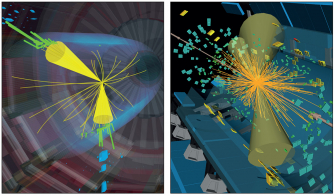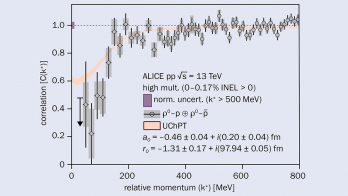Inclusive πK production via the interaction p + Ni → π−K+ + X. The ionisation or break up of AKπ leads to so-called atomic pairs.
Image credit: arXiv:1605.06103v1.
The DIRAC (DImeson Relativistic Atom Complex) experiment at CERN has discovered a new type of exotic atom made up of a π and K meson. The “strange dimesonic” state provides an ideal laboratory for testing quantum chromodynamics (QCD) in the low-energy region and joins a long list of non-standard atoms, which also include positronium, muonic atoms and antihydrogen, that help physicists study in detail how particles interact.
The πK system is a type of hadronic atom in which meson pairs are bound electromagnetically, similar to pionium (a π+π– atom), which was studied previously by the DIRAC experiment. It was produced by firing 24 GeV/c protons from CERN’s Proton Synchrotron (PS) into platinum or nickel foil targets. Here, relativistic dimesonic bound states formed by Coulomb final-state interactions move inside the target and can break up, resulting in particle pairs characterised by a small relative momentum in the centre-of-mass system of the pair. The recently upgraded DIRAC experiment observed 349±62 such atomic pairs, corresponding to a signal of 5.6σ.
The observation is part of an effort that began almost a decade ago, when the DIRAC collaboration reported a 3.2σ enhancement of πK pairs at low relative momentum based on a platinum target. This was followed in 2014 by 3.6σ evidence using a nickel target. The latest result is based on data obtained in both platinum and nickel targets, also using information from all subdetectors and enhanced background description based on Monte Carlo simulations, and represents the first statistically significant observation of the strange dimesonic πK atom.
The team is now working towards a measurement of the πK atom lifetime, which is predicted to be 3.5±0.4 fs. This will allow DIRAC to measure for the first time a parameter of low-energy πK interactions called the scattering length. With an expected precision of around 35%, the result can then be compared with precise predictions from lattice QCD and chiral perturbation theory. The latter provides a way to predict scattering lengths in the low-energy sector of QCD and to study a potential flavour dependence of the quark condensate responsible for chiral-symmetry breaking.
“A recent study has shown that the production rate of πK atoms from the proton beam of CERN’s Super Proton Synchrotron will be 25 times higher compared to that from the PS,” explains DIRAC spokesperson Leonid Nemenov. “This will allow us to measure the πK scattering lengths with a precision better than 5% and to check the precise predictions of QCD for these values basing on a Lagrangian describing u, d and s quarks. The DIRAC collaboration is now planning to prepare the dedicated Letter of Intent for such an experiment.”








